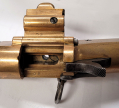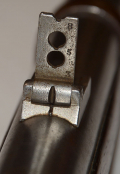site search
online catalog
CIVIL WAR FIRST MODEL, FIRST CONTRACT, WARNER CARBINE SERIAL #113

$6,250.00 ON HOLD
Quantity Available: 1
Item Code: 172-5980
The Warner is an attractive brass frame carbine- in fact, the only brass frame carbine purchased by the U.S. during the war. This is a very good example of the First Model Warner, delivered in 1864, and known to have been used by the 1st Wisconsin and 3rd Massachusetts Cavalry Regiments, and possibly by the 1st Colorado. Developed by James Warner (1818-1870,) who had a history in the arms business, having worked with Eli Whitney and as superintendent of the Springfield Arms Company, the carbine is a single-shot breechloader firing a .50 caliber rimfire cartridge made for Warner by Crittenden & Tibbals. It is loaded by placing the hammer at half-cock and swinging the breechblock over to the right to insert the cartridge. After firing, a sliding ejector mounted on the bottom of carbine permits the empty case to be drawn from the chamber.
The government agreed to purchase 1,000 of these carbines on January 13, 1864. A sample or inspection carbine was delivered on January 24, and the contract fulfilled by deliveries in March, April, and June 1864. In late October Warner offered an additional 500 carbines. The offer was accepted and the carbines delivered to the New York Arsenal on November 15, 1864. The total thus amounted to 1,501 guns. A second contract was signed in December 1864 for 2,500 carbines of a slightly different design, made and marked by the Greene Rifle Works, which were delivered in February and March 1865.
This has a pleasing medium bright brass receiver and mellow buttplate, with semi-bright barrel (they are both bright and blued according to McAulay,) and warm brown butt and forestock. Front and rear sights are in place, with rear sight retaining the sight leaf, marked for 300, 500 and 800 yards. The receiver is stamped in three lines on the left side “JAMES WARNER. SPRINGFIELD. MASS / WARNER’S / PATENT.” Some First Model Warner’s have no marking on the receiver and are thought to be from the first 200 carbines delivered about March 31, 1864, since they had likely been produced before Warner actually received his February 23, 1864, patent on the semi-cylindrical channel in the breech for loading the cartridge. Whether all two hundred in that delivery were unmarked is unclear and this one is serial numbered 113, suggesting it is very early in the production run, even if the guns were not assembled or delivered in precise serial number sequence. We note in passing, also, that the marking on the receiver was applied by three stamps, not all in alignment, perhaps indicating an early or rushed job. The breech block and receiver have matching assembly numbers: “02.”
The barrel shows as bright with some very fine gray spots and salt and peppering, with a darker barrel band showing some light pitting on the underside. The barrel shows a small “L” inspector stamp near the breech and the same letter appears elsewhere on the carbine. The receiver shows some dings on the left side. The hammer and trigger show nice color. The sling ring is in place and is the correct early style for the Warner- a simple ring on eye-bolt rather than conventional sling bar (adopted for the Second Model.) The ejector, latch, etc., are all present and functional. The butt plate has a mellow brass tone with some darker age spots. The forestock and buttstock match in color. The forestock has a few dark stains and little wear on the upper edge just forward of the barrel band on the right. The buttstock has some light dings on the bottom on the right and a drag line just below the top edge running couple of inches. The left butt has some minor handling marks, a couple of very small dings near the buttplate, and what looks like a shall carved initial “H” that obscures any inspection cartouche. The mechanics work well. The bore is clean and the rifling is visible, though not pronounced.
The 1st Wisconsin Cavalry had 200 Warners in their inventory by September 1864 and 341 in February 1865, though was rearmed with Spencers for Wilson’s raid. The 3rd Massachusetts was issued them for field trials in January 1865, but issued Sharps carbines for the Spring campaign. McAulay (1996) also notes a February 1865 request to the St. Louis Arsenal for accoutrements for the carbine from the Governor of Colorado, implying the 1st Colorado Cavalry may have received them. The carbines were favorably regarded for accuracy, but the ejecting system was faulty, requiring the withdrawn cartridge to be removed with the fingers or shaken out, the attachment of the forestock too weak, as was the wrist. Greater complaints were made about failures in firing cartridges, likely due to the inferior Crittenden & Tibbals rounds, or difficulty in extracting cartridges, a problem likely exacerbated by the use of Spencer cartridges in First Models bored for those slightly smaller Crittenden & Tibbals Warner cartridges. This defect was remedied by adoption of the .56-50 Spencer round for the Second Model Warner and reaming out of the chambers of the First Models. By that time the fighting was over, of course, but they do seem to have seen some limited use for the next couple of years until many were sold off to France for use in the Franco-Prussian War.
This carbine has a very pleasing look and would likely fill an empty place in a Civil War arms collection or cavalry display. [sr][ph:L]
DISCLAIMER: All firearms are sold as collector's items only - we do not accept responsibility as to the shooting safety or reliability of any antique firearm. All firearms are described as accurately as possible, given the restraints of a catalog listing length. We want satisfied customers & often "under" describe the weapons. Any city or state regulations regarding owning antique firearms are the responsibility of the purchaser. All firearms are "mechanically perfect" unless noted, but again, are NOT warranted as safe to fire!
~~~~~~~~~~~~~~~~~~~~~~~~~~~~~~~~~~~
THIS ITEM, AS WITH ALL OTHER ITEMS AVAILABLE ON OUR WEB SITE,
MAY BE PURCHASED THROUGH OUR LAYAWAY PROGRAM.
CLICK HERE FOR OUR POLICIES AND TERMS.
THANK YOU!
Inquire About CIVIL WAR FIRST MODEL, FIRST CONTRACT, WARNER CARBINE SERIAL #113
For inquiries, please email us at [email protected]
Most Popular
Historical Firearms Stolen From The National Civil War Museum In Harrisburg, Pa »
Theft From Gravesite Of Gen. John Reynolds »
Cavalry Carbine Sling Swivel »
Fine Condition Brass Infantry Bugle Insignia »
featured item
RARE USN GOSPORT NAVY YARD PRIMING FLASK
Gosport Shipyard was the original name of the facility in Portsmouth, Virginia, that was founded in 1767, passed into the hands of Virginia in the Revolution, was leased from that state by the U.S. government in 1794, purchased by them in 1801 and… (490-6824). Learn More »




















